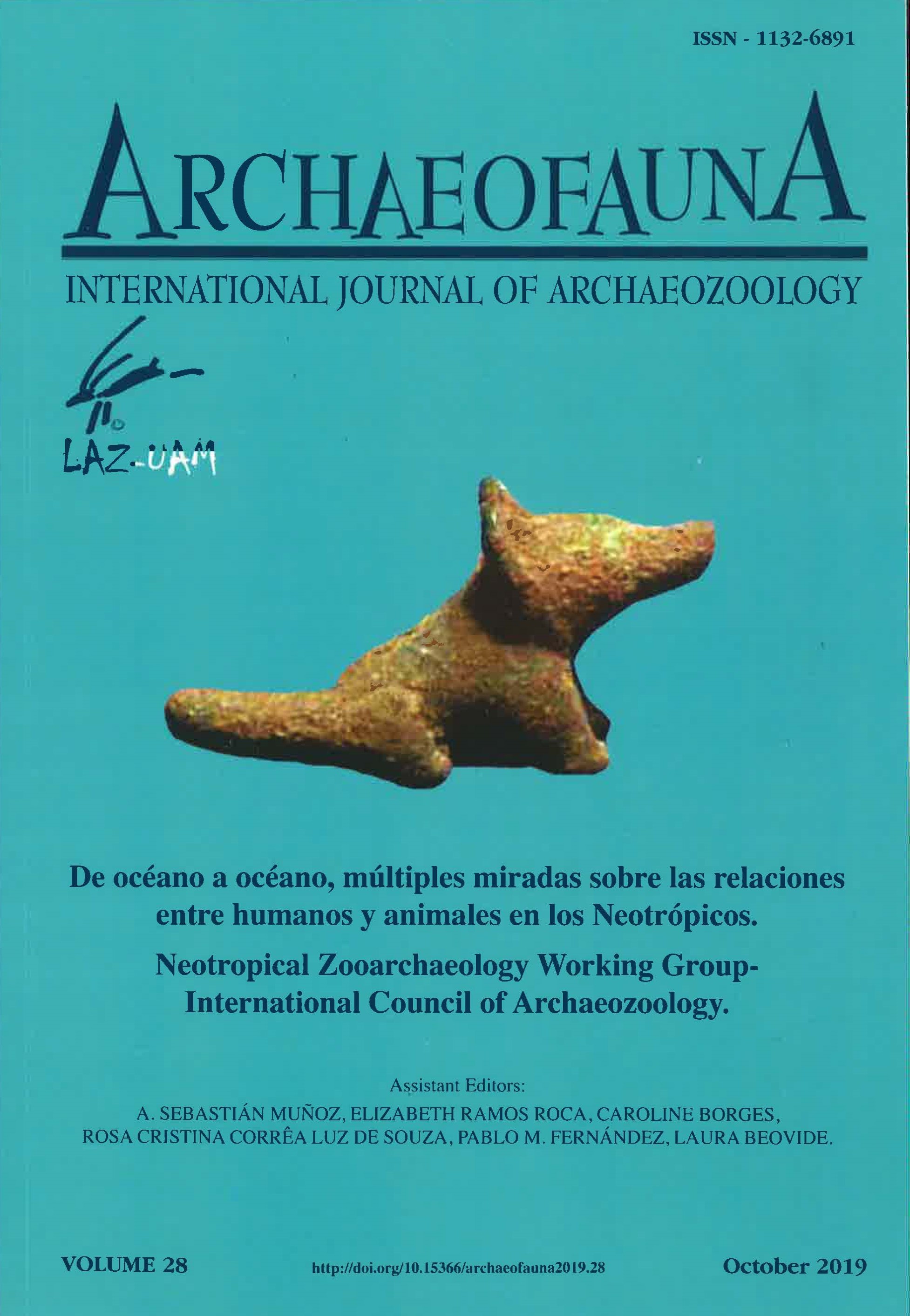Sambaquis as a proxies of late Holocene mollusk diversity on the coast of Rio de Janeiro, Brazil
Mots-clés :
MOLLUSKS, TAXONOMIC DISTINCTNNES, FEEDING GUILDS, SHELL MOUNDS, FUNCTIONAL DIVERSITY, ARCHAEOZOOLOGYRésumé
Efficiency of archaeozoological vestiges from shell mounds to recover biodiver- sity patterns were tested using a meso-scale inventory (150 archaeological sites from Rio de Janeiro Coast) of malacological vestiges from sambaquis against an inventory of present times mollusk species recorded for the same area. Statistical analysis were done using Taxonomic Dis- tinctness tests and Trophic Diversity inferences. No statistical significant differences were found between past (sambaquis) and present day inventories of malacofauna. It is concluded that sam- baquis can be valuable proxies of mollusks biodiversity from Late Holocene. Furthermore, it is supported that the incorporation of information from archaeozoological vestiges to biodiversity studies can bring a historical and evolutionary perspective for the field.
Téléchargements
Références
Amesbury, J.R. 2007: Mollusk collecting and environmental change during the prehistoric period in the Mariana Islands. Coral Reefs 26: 947-958. https://doi.org/10.1007/s00338-007-0274-2
Antolí, V.F. & García-Cubas, A. 1985: Sistemática y ecología de moluscos em las lagunas costeras Carmen y Machona, Tabasco, México. Anales del Instituto de Ciencias del Mar y Limnologia de la Universidad Nacional Autônoma de Mexico 12: 145-198.
Arruda, E.P.; Domaneschi, O. & Amaral, A.C.Z. 2003: Mollusc feeding guilds on sandy beaches in São Paulo State, Brazil. Marine Biology 143: 691-701. https://doi.org/10.1007/s00227-003-1103-y
Baiser, B.; Ardeshiri, R.S. & Ellison, A.M. 2011: Species richness and trophic diversity increase decomposition in a co-evolved food web. PLoS ONE 6(5): e20672. https://doi.org/10.1371/journal.pone.0020672
Baisre, J. 2010: Setting a baseline for Caribbean fisheries. Journal of Island and Coastal Archaeology 5: 120-147. https://doi.org/10.1080/15564891003663943
Beauclair, M.A.; Duarte, M.R. & Silva, E.P. 2016: Sambaquis (shell mounds) and mollusk diversity in the past history of Araruama Lagoon, Rio de Janeiro, Brazil. Pan-American Journal of Aquatic Sciences 11: 47-59.
Clarke, K.R. & Warwick, R.M. 1998: A taxononomic distinctness index and its statistical properties. Journal of Applied Ecology 35: 523-531. https://doi.org/10.1046/j.1365-2664.1998.3540523.x
Denadai, M.R.; Amaral, A.C.Z. & Turra, A. 2001: Spatial distribution of molluscs on sandy intertidal substrates with rock fragments in south-eastern Brazil. Estuarine, Coastal and Shelf Science 53: 733-743. https://doi.org/10.1006/ecss.2001.0817
Fa, D. 2008: Effects of tidal amplitude on intertidal resource availability and dispersal pressure in prehistoric human coastal populations: The Mediterranean-Atlantic transition. Quaternary Science Reviews 27: 2194-2209. https://doi.org/10.1016/j.quascirev.2008.07.015
Faria, R.G.S.; Silva, E.P. & Souza, R.C.C.L. 2014: Biodiversity of Marine Molluscs from Sambaqui da Tarioba, Rio das Ostras, Rio de Janeiro (Brazil). Revista Chilena de Antropologia 29(1): 49-54.
Lima, T.A. 2000: Em busca dos frutos do mar: os pesca-dores-coletores do litoral centro-sul do Brasil. Revista USP 44: 270-327. https://doi.org/10.11606/issn.2316-9036.v0i44p270-327
Lima, T.A.; Macário, K.D.; Anjos, R.M.; Gomes, P.R.S.; Coimbra, M.M. & Elmore, E. 2002: The antiquity of the prehistoric settlement of the central-south Brazilian coast. Radiocarbon 44: 733-738. https://doi.org/10.1017/S0033822200032185
- 2003: AMS dating of early shellmounds of the southeastern Brazilian coast. Brazilian Journal of Physics 33: 276-279. https://doi.org/10.1590/S0103-97332003000200020
Lindbladh, M.; Brunet, J.; Hannon, G.; Niklasson, M.; Eliasson, P.; Eriksson, G. & Ekstrand, A. 2007: Forest history as a basis for ecosystem restoration: a multidisciplinary case study in a south Swedish temperate landscape. Restoration Ecology 15: 284-295. https://doi.org/10.1111/j.1526-100X.2007.00211.x
Mendes, A.B.; Silva, E.P. & Souza, R.C.C.L. 2014: Biodiversity of Marine Fishes from Shellmounds of Ilha Grande Bay, Rio de Janeiro, Brazil. Revista Chilena de Antropología 29: 55-59.
Mendes, A.b.; Duarte, M.R. & Silva, E.P. 2018: Biodiversity of Holocene marine fish of the southeast coast of Brazil. Biota Neotropica 18(1): e20170394. https://doi.org/10.1590/1676-0611-bn-2017-0394
Morey, D.F.; Crothers, G.M.; Stein, J.K.; Fenton, J.P. & Herrmann, N.P. 2002: The fluvial and geomorphic context of Indian Knoll, an Archaic shell midden in West-Central Kentucky. Geoarchaeology 17(6): 521-553. https://doi.org/10.1002/gea.10027
Padua, S.C.; Duarte, M.R. & Silva, E.P. 2016: Recuperação de padrões de biodiversidade a partir de vestígios zooarqueológicos de sambaquis. In: III Encuentro Latinoamericano de Zooarqueologia, Aracaju, Brasil.
Rios, E.C. 1994: Seashells of Brazil. FURG, Rio Grande.
- 2009: Compendium of brazilian sea shells. Evangraf, Rio Grande.
Sandweiss, D.H. 2003: Terminal Pleistocene through mid-Holocene archaeological sites as paleoclimatic archives for the Peruvian coast. Palaeogeography, Palaeoclimatology, Palaeoecology 194(1-3): 23-40. https://doi.org/10.1016/S0031-0182(03)00270-0
Scheel-Ybert, R.; Eggers, S.; Wesolowski, V.; Petronilho, C.C.; Boyadjian, C.H.; Gaspar, M.D.; Barbosa-Guimarães, M.; Tenório, M.C.; Deblasis, P. 2009: Subsistence and lifeway of coastal Brazilian moundbuilders. Treballs d' Etnoarqueologia 7: 37-53.
Silva, E.P.; Pádua, S.C.; Souza, R.C.C.L. & Duarte, M.R. 2017: Shell Mounds of the Southeast Coast of Brazil: Recovering Information on Past Malacological Biodiversity. In: Mondini, M.; Muñoz, A.S. & Fernández, P.M. (eds.): Zooarchaeology in the Neotropics. Springer International Publishing, New York. https://doi.org/10.1007/978-3-319-57328-1_4
Souza, R.C.C.L.; Trindade, D.C.; Decco, J.; Lima, T.A. & Silva, E.P. 2010a: Archaeozoology of marine mollusks from Sambaqui da Tarioba, Rio das Ostras, Riode Janeiro, Brazil. Zoologia 27: 363-371. https://doi.org/10.1590/S1984-46702010000300007
Souza, R.c.c.l., Lima, T.A. & Silva, E.P. 2010b: Holocene molluscs from Rio de Janeiro state coast, Brazil. Check List 6(2): 301-308. https://doi.org/10.15560/6.2.301
- 2011: Conchas Marinhas de Sambaquis do Brasil. Technical Books Editora, Rio de Janeiro.
- 2012: Remarks on the biodiversity of marine molluscs from late Holocene Brazilian shell mounds. In: Christine, L. (ed.): Proceedings of the General Session of the 11th International Council for Archaeozoology Conference. Archaeopress, Oxford.
Souza, R.C.C.L.; Lima, T.A.; Duarte, M.R. & Silva, E.P. 2016: Changes in patterns of biodiversity of marine mollusks along the Brazilian coast during the late Holocene inferred from shell-mound (sambaquis) data. Holocene 26(11): 1802-1809. https://doi.org/10.1177/0959683616645946
Van Der Schriek, T.; Passmore, D.G.; Mugica, F.F.; Stevenson, A.C.; Boomer, I. & Rolão, J. 2008: Holocene palaeoecology and floodplain evolution of the Muge tributary, Lower Tagus Basin, Portugal. Quaternary International 189: 135-151. https://doi.org/10.1016/j.quaint.2007.09.007
Villagran, X.S. & Giannini, P.C.F. 2014: Shell mounds as environmental proxies on the southern coast of Brazil. The Holocene 24(8): 1009-1016. https://doi.org/10.1177/0959683614534743
Waselkov, G.A. 1987: Shellfish gathering and shellmidden archaeology. In: Schiffer, M.B. (ed.): Advances in Archaeological Method and Theory 10: 93-210. Academic Press, New York. https://doi.org/10.1016/B978-0-12-003110-8.50006-2
Worms Editorial Board 2018: World Register of Marine Species. Available from http://www.marinespecies. org at VLIZ. Accessed 2018-10-01. doi:10.14284/170.

